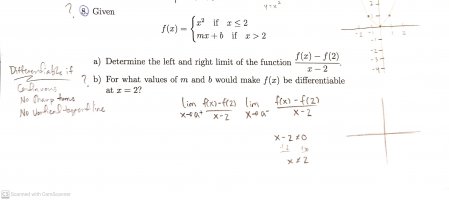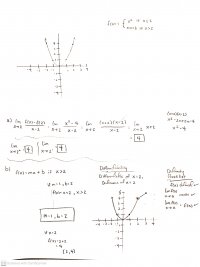kmunzenmaier
New member
- Joined
- Oct 11, 2021
- Messages
- 5
Hi everyone,
I'm having a lot of trouble with this question on my instructor's Midterm Review; I know how to determine left-hand and right-hand limits when the value of a is given (the value that x approaches), but we haven't been given this type of problem in the homework or the textbook for finding the left and right limit of a function without any value of a being given. Are there any great examples of how to solve a problem of this type when the value of a isn't provided for determining the left and right limit of a function?

Based on the given function for Part a), I know that the function is undefined when x=2, but the left and right limit could still exist at this point despite the discontinuity; is there a method/formula I'm missing for determining the left and right limit generally for the function (I have no idea how to find left and right limits without a given value of a)
Part b) is also very weird to me since we've never been given anything like this in the homework or the textbook (I made a differentiability checklist to the left of Part b) showing the "rules" but I'm still not fully understanding how to find the values of m and b based on differentiability ~ the homework we're given is completely different from the Midterm Review questions so I'm pretty stumped when it comes to these types of questions) It feels like Part b) might be a trick question though since the domain of f(x)=mx+b in the piecewise-defined function is limited to the domain of all x values greater than 2 :/
Any help is appreciated ~ thank you
I'm having a lot of trouble with this question on my instructor's Midterm Review; I know how to determine left-hand and right-hand limits when the value of a is given (the value that x approaches), but we haven't been given this type of problem in the homework or the textbook for finding the left and right limit of a function without any value of a being given. Are there any great examples of how to solve a problem of this type when the value of a isn't provided for determining the left and right limit of a function?

Based on the given function for Part a), I know that the function is undefined when x=2, but the left and right limit could still exist at this point despite the discontinuity; is there a method/formula I'm missing for determining the left and right limit generally for the function (I have no idea how to find left and right limits without a given value of a)
Part b) is also very weird to me since we've never been given anything like this in the homework or the textbook (I made a differentiability checklist to the left of Part b) showing the "rules" but I'm still not fully understanding how to find the values of m and b based on differentiability ~ the homework we're given is completely different from the Midterm Review questions so I'm pretty stumped when it comes to these types of questions) It feels like Part b) might be a trick question though since the domain of f(x)=mx+b in the piecewise-defined function is limited to the domain of all x values greater than 2 :/
Any help is appreciated ~ thank you

